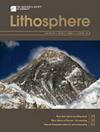晚中生代以来大兴安岭发掘史:对东北亚构造格局变化的启示
IF 1.7
4区 地球科学
Q3 GEOCHEMISTRY & GEOPHYSICS
引用次数: 1
摘要
大兴安岭是东北亚地区一个重要的造山带,对蒙古-鄂霍次克洋和太平洋显生宙的演化具有重要意义。对大兴安岭地区及其伴生盆地进行了低温热年代学综合研究。对中国东北gkm碎屑样品进行的磷灰石裂变径迹(AFT)测试得出的中心年龄在260 - 62 Ma之间。利用二维热历史反演模型和三维数值模拟研究了gkm的热历史,揭示了至少两个不同的构造冷却和挖掘事件:一个发生在147 - 70 Ma之间,另一个发生在35 Ma左右。gkm盆地、海拉尔-二连盆地和漠河盆地的裂变径迹年龄有一定的相似性(105 Ma),但松辽盆地的结果是独特的。这表明松辽盆地和gkm在这一时期可能受到不同构造域的影响,而AFT时代在105 ~ 45 Ma之间达到顶峰,表明盆地-山系可能受到统一的古太平洋板块作用的影响,该作用在105 Ma左右开始盛行。147 ~ 70 Ma的降温事件可归结为早白垩世蒙古-鄂霍次克洋闭合引起的挤压造山作用和晚白垩世早期古太平洋俯冲引起的伸展造山作用的综合作用。自大约35 Ma以来,太平洋板块俯冲速度的增加可能在gkm中建立了一个持续至今的弧后伸展构造环境。本文章由计算机程序翻译,如有差异,请以英文原文为准。
Exhumation History of the Greater Khingan Mountains (NE China) Since the Late Mesozoic: Implications for the Tectonic Regime Change of Northeast Asia
Abstract The Greater Khingan Mountains (GKMs) are a prominent orogenic zone in Northeast Asia that offers significant insights into the evolution of the Mongol-Okhotsk Ocean and the Pacific Ocean during the Phanerozoic. A comprehensive study integrating a low-temperature thermochronology analysis pertaining to the Greater Khingan area and its associated basins has been conducted. Apatite fission-track (AFT) tests conducted on detrital samples from the GKMs in Northeast China have yielded central ages ranging from 260 to 62 Ma. Two-dimensional thermal history inversion modeling and three-dimensional numerical simulations were used to investigate the GKMs' thermal history, revealing at least two distinct tectonic cooling and exhumation events: one occurring between 147 and 70 Ma and another around 35 Ma. The fission-track age groups of the GKMs, Hailar-Erlian Basin, and Mohe Basin bear some resemblance (>105 Ma), but the results from the Songliao Basin are unique. This implies that the Songliao Basin and the GKMs were likely under the influence of different tectonic domains during this period, while AFT age peaks between 105 and 45 Ma, indicating the basin-mountain systems were likely influenced by a unified Paleo-Pacific plate process, which prevailed from about 105 Ma. The 147–70 Ma cooling event can be attributed to the combined effects of the compression orogeny, resulting from the closure of the Mongol-Okhotsk Ocean during the Early Cretaceous and the extension orogeny triggered by the subduction of the Paleo-Pacific Ocean during the early Late Cretaceous. Since approximately 35 Ma, the increase in Pacific plate subduction speed may have established a post-arc extensional tectonic environment in the GKMs that has persisted until now.
求助全文
通过发布文献求助,成功后即可免费获取论文全文。
去求助
来源期刊

Lithosphere
GEOCHEMISTRY & GEOPHYSICS-GEOLOGY
CiteScore
3.80
自引率
16.70%
发文量
284
审稿时长
>12 weeks
期刊介绍:
The open access journal will have an expanded scope covering research in all areas of earth, planetary, and environmental sciences, providing a unique publishing choice for authors in the geoscience community.
 求助内容:
求助内容: 应助结果提醒方式:
应助结果提醒方式:


